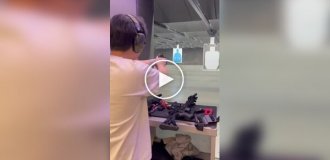"Berdanka" is a common noun for samples, rifles, and carbines. Mosin’s three-rulers are often called “berdanka”, but not everyone knows where this word comes from and what it means.

Any hunter has heard of the Berdanka, and some parents even hunted with it. However, these days, few people know exactly what it is. One believes that the Berdanka is a combat rifle; others are a hunting rifle converted from a combat rifle; third - a hunting rifle of a special design; fourth - a smoothbore gun converted from a combat rifle; fifth - a smooth-bore gun, converted from a combat rifle of any system... The vast majority of hunters are convinced: smooth-bore Berdan guns were certainly of small calibers, which, let’s say right away, is not true.
It should be noted that some people confuse a smooth-bore Berdanka with a single-barreled hunting rifle converted from a S.I. Mosin rifle. The design of the hunting weapon, created on the basis of the famous three-line, was developed by P. N. Frolov; This gun was produced from the first years of Soviet power until the start of the Great Patriotic War. Unlike Berdankas, which were single-shot, frolovkas (as hunters began to call this gun) were produced in both single-shot and magazine versions, 20, 24, 28 and 32 calibers.
In 1945-1947, the USSR produced a single-shot 32-caliber hunting rifle using parts from a Mosin rifle, which was called TOZ-32 (T-1). Well, let’s talk more about Berdankas
Colonel Hiram Berdan

In 1866, Colonel GAU (Main Artillery Directorate) A.P. Gorlov and the clerk of the Armory Commission, Lieutenant K.I. Gunius was sent to the United States to select new weapons for the Russian army. At that time, the leading position of American designers and industrialists in the creation of effective small arms was no longer in doubt.
During their business trip, Gorlov and Gunius drew attention to the Berdan rifle with a forward-swinging bolt, which was already purchased by Great Britain and Spain.
However, according to Russian experts, the rifle and cartridge needed significant improvement. The result was a 4.2-linear (10.67 mm) cartridge with a solid-drawn case and a rifle with a folding bolt and an internal linearly moving hammer. In the USA they were called “Russians”, in Russia they were called “Berdan systems”. And if this was applicable to the cartridge, then the rifle itself would be more correctly called the Gorlov-Gunius system. It entered service under the designation “Rifle rifle mod. 1868." At first, individual rifle units were re-equipped with the new rifle due to its excellent accuracy at that time.
The Gorlov-Gunius rifle (aka Berdan No. 1) was ordered from the Colt plant, and the cartridges were ordered from the Bridgeport plant.

But the Gorlov-Gunius rifle did not manage to become an infantry rifle. Hiram Berdan, who arrived in Russia in April 1869, proposed adapting a longitudinally sliding rotary bolt to a 4.2-line rifle. The metal cartridge made it possible to reveal all the advantages of a longitudinally sliding bolt, which sent the cartridge into the chamber and ejected the spent cartridge case, simplified and accelerated the reloading process and soon became the most commonly used in small arms.
The rifle under the name “Berdan rapid-fire small-caliber rifle number 2” was adopted by the Russian army. The rifle that entered service with rifle units was designated “Berdan System Infantry Rifle No. 2.”
In the same 1870 and the following 1871, samples of cavalry rifles were manufactured, tested and approved: dragoon, Cossack and cavalry carbine, all of the same Berdan system with a sliding bolt.
The Russian 4.2-line cartridge was the first to receive a bottle case; the ratio between the weight of the bullet and the charge turned out to be well chosen (brown gunpowder was chosen for it). The bullet was made by casting, later by stamping, and in the cartridge it was wrapped in paper, the color of which indicated a full or weakened charge. The Berdanka, as the rifle soon became known, was equipped with a tetrahedral bayonet. According to its design and characteristics, the rifle mod. 1870 turned out to be one of the best for that time.
Berdan No. 2 was the last single-shot Russian rifle, which was in service until the 1890s, i.e. until a new large-scale rearmament of the army.
But even after it, the “Berdanka” was destined to have a long history - after being replaced by the Mosin “three-line” rifle, large numbers of old rifles were converted into hunting rifles, and others served in this capacity for many decades (and are still serving!).

In addition, most of the military schools of Imperial Russia retained a certain number of these rifles. Berdan rifles and ammunition for them were stored in warehouses and fortresses in huge quantities as a mobilization reserve. The destruction of old rifles was a costly affair, which is why it was much more profitable for the treasury to convert them into civilian weapons rather than to dispose of them by melting them down. However, such large stocks of rifles, even at a price of 10–15 pre-war rubles, clearly exceeded the potential capacity of the Russian domestic arms market, therefore at the beginning of 1914 there were a lot of Berdan rifles in warehouses. The losses of rifles in the first battles of the “Great War” and the impossibility of quickly expanding the production of Mosin rifles forced the GAU to remember old stocks. Initially, they did not intend to use outdated weapons at the front, wanting to limit themselves to rear use to protect bridges, railways and warehouses in the depths of Russia. This use of Berdan rifles was a completely reasonable measure. Mosin rifles not used for combat purposes could be transferred to the front. But the rapidly growing shortage of weapons forced the use of outdated Berdan rifles on the front line, for example, during the defense of the Novogeorgievsk fortress, about half of the fighters of its garrison were unarmed, and about a third of the armed defenders had Berdan rifles and only 300 rounds of ammunition per rifle. On the front line, the situation with with weapons the situation was even worse. In such a situation, any weapon was considered combat-ready, even outdated single-shot Berdan rifles. Moreover, at first the Entente offered Russia “help” in the form of French Gras-Kropachek and Italian Vetterli-Vitali rifles that had been removed from service.

With the meager quantities of ammunition supplied for these rifles, there could be no question of their serious combat use, although in terms of rate of fire they were superior to the Berdan Rifle due to magazine feeding.
Black powder rifles did not remain on the front line for long: the smoke unmasking the shooter and the insufficient rate of fire did not allow the unit armed with them to restrain the enemy, much less fight successfully. In addition, the Germans, in their propaganda, hysterically condemned the use of non-jacketed bullets, citing the fact that the wounds they inflict are much worse than those caused by bullets from modern rifles, drawing a parallel with “dum-dum” bullets, which, of course, is technically incorrect . One way or another, the use of old black powder rifles was a forced and temporary measure; they very soon left the battlefields forever.
After the rearmament of the Russian army with Mosin rifles, the question arose of what to do with the hundreds of thousands of Berdan rifles that had been withdrawn from service. The way out of this situation was found quite simply. In a letter from the Main Artillery Directorate (1902) we read the following; “The Military Council decided: 1) to allow the delivery of 50 thousand barrels and boxes... of Berdan rifles from artillery warehouses for drilling to the Imperial Tula Arms Factory... 2) to allow... the factory for drilling barrels and boxes... to sell them to artisans and small arms manufacturers...”

The sale of parts from Berdanov rifles continued in subsequent years. Thus, in 1911, 150 thousand rifles were delivered to the Tula plant for drilling and further sale from the warehouses of the Moscow District, 100 thousand from the warehouses of the Kyiv District, 50 thousand from the warehouses of the Vilna District. In Tula, sales were carried out at the following prices; barrel - for 1 rub. 07 kopecks, bolt - 83 kopecks, box - 54 kopecks, stock - 16 kopecks, mechanism - 14 kopecks, device - 7 kopecks. Thus, everything needed to assemble the gun cost 2 rubles. 81 kop. Despite the low prices, the plant made a large profit from the sale of rifles that lay as dead weight. For the period 1902-1908. trunks, boxes, stocks and bolts were sold for 326 thousand rubles.
Tula handicraftsmen were engaged in purchasing parts of old weapons, altering and assembling them. According to archival data, in the period 1903-1915. 80 people were engaged in this business. In turn, the craftsmen threaded the hunting rifles they collected at a price of 6 to 14 rubles. depending on the finish. Smooth-bore Berdan guns from 12 to 32 calibers with metal finishing blued, engraved, nickel-plated, with a walnut or birch stock went on sale. It is curious that A. M. Averin’s price list even advertises “children’s Berdan” 12 - 20 calibers costing from 10 to 12 rubles. 75 kop. We can name the following Tula gunsmiths and artisans who made berdanks: A. M. Averin, I. V. Vagin, D. I. Kopteltsev, A. N. Kuznetsov, S. I. Malikov, I. V. Mashkov, N. G. Neveronov, N. V. Novikov, F. P. Petrov, N. A. Rudakov, D. B. Rudakov, S. S. Sushkin, I. A. Chernov and others.

At the same time as artisans, the Tula Arms Factory was also producing hunting rifles converted from military rifles. Since 1902, a special hunting workshop was organized at the plant, and the production of smooth-bore hunting rifles converted from Berdan rifles was launched. According to archival documents, in 1910, 15.3 thousand guns of various calibers (12, 16, 20, 24, 28, 32) were made, both with cylindrical drilling and with a muzzle constriction. In addition to smoothbore shotguns, rifled carbines chambered for Smith-Wesson and Winchester 44 caliber (11.18 mm) cartridges were also produced on the basis of the Berdan rifle. The barrel length of such a carbine was 66.04 cm, weight - about 3.3 kg.
After 1915, due to the First World War, the production of hunting rifles, both by factories and by artisans, ceased. It was resumed under Soviet rule. In 1920-1930 a number of smooth-bore Berdan guns were produced in Tula and Izhevsk.
So, we see that in our country there were the following types of weapons associated with the name of the American designer Berdan: 1 - Berdan No. 1 combat rifle with a folding bolt; 2 - Berdan No. 2 combat rifle with a longitudinally sliding bolt; 3 - hunting rifles and carbines of various calibers, converted from the Berdan No. 2 combat rifle; 4 - hunting smoothbore shotguns of various calibers, converted from the Berdan No. 2 combat rifle.























